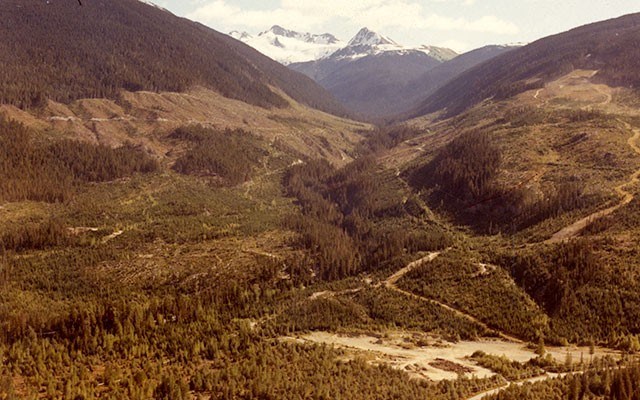It seemed almost fitting that the rain began to fall this week (OK, deluge might be a better description of the wet stuff) as we head toward, and into, the Labour Day long weekend.
In many ways September always feels like the beginning of the new year — school is heading back, whether that is elementary, secondary or post secondary, summer's warmth is becoming a memory, and the resort is getting ready for what it was born to do — share one of the world's best winter adventure playgrounds.
It may be impossible to imagine, but Whistler wasn't always top of the heap when it came to skiing and enjoying the snow-sliding sports.
And with this week marking the 40th anniversary of the Resort Municipality of Whistler, it's a good time to reflect on how dreams came true in the founding of this town.
Most know the story now of how Whistler almost didn't happen — citizens, interest groups and even council of the day were at odds over the development of the village about a year after the then NDP government introduced the Resort Municipality of Whistler Act in the spring of 1975.
Council, lead by mayor Pat Carleton, was ready to go ahead with plans for development, but the province just sat twiddling its thumbs. Finally, with letters of resignation in their back pockets in case things didn't go their way, Carleton and his council went to Victoria to demand action.
Needless to say no resignations were handed in, and today's meandering Village Stroll and pedestrian village are just two pieces of Whistler's equation for success that grew out of those early days.
Underlying all the great stories about Whistler's success are, of course, the people who gave the resort life along the way.
From the great athletes who made and make this town their home — far too many to mention here — to those who got the first financial institution going, or the first physiotherapy office, and even the first daycare operating, all played a role in creating the town we know today.
The town grew, the neighbourhoods grew, a thriving community became the basis of B.C.'s most successful resort.
As we have experienced, success brings its own challenges — for Whistler one of these things has been the number of people who head out to enjoy the backcountry of our amazing environment and find themselves in trouble — sometimes very serious trouble.
Typical of the community of Whistler, when a need was identified people stepped in to fill the void.
It was the winter of 1972 that it hit home that a search and rescue organization was needed. On a stormy Saturday four weekend skiers failed to pick up their kids at the Creekside parking lot. When it became clear the skiers weren't going to show up an impromptu group of volunteers set to out assist the mountain's ski patrollers to look for them.
Sunday was another stormy day, but Monday the weather cleared enough for Jim McConkey (then ski school director and owner of McCoos) to notice a line of avalanche debris in Harmony. Sadly, the bodies were discovered there.
The episode was the catalyst for the formation of Whistler Search and Rescue, one of the busiest SAR outfits in B.C. The early group — Dave Cathers, Cliff Jennings, Bernie Brown, Stephan Ples, John Anderson, Al Schmuck, Roger McCarthy, Brad Sills (still heading up the organization to this day), Trudy Salmhoffer and a few others founded a fellowship that is stronger today than ever (Editor's note: the annual SAR fundraising dinner will be held Oct.17 at Dusty's — get a ticket).
Speaking of Dusty's... it would really be remiss if Whistler marked its anniversary with no mention of the resort's most famous equine resident — Dusty the stuffed horse. According to long-time corridor resident (and SAR member) Dave Steers, Dusty's was commonly known as the Deadhorse after the mountain took over operations of the bar in the 1980s
"They called it that because the centerpiece of the bar was, no kidding, a dead horse," wrote Dave Steers in 2000. "The poor animal was forever frozen in a bucking position, back arched and legs extended. He was dressed in his saddle and tack.
"This dead animal came from the southern United States. He had been a famous Texas bronco horse in the 1920's. His name was Dusty. Apparently he liked to travel."
It became a popular draw as you can imagine. The story goes that if you got on the horse naked the house would buy drinks for everyone.
And inevitably the horse was part of many April Fool's jokes.
"He ended up on top of a tower on the Little Red Chair one year," wrote Steers. "It can't have been easy to get a stuffed horse on top of a lift tower but somebody managed it."
Another time he ended up on, of course, Pony Trail ski run.
As time wore on Dusty had several new owners but at the end the steed had the last laugh. Somehow the horse went to the bottom of the Cheakamus River where he was spotted by kayakers. They called the RCMP, which sent a dive team thinking they were dealing with someone's real dead horse — even drawing a picture of his brand and circulating it to find the owner. Once rescued he had one last prank to play — he was found outside the lift shack on Blackcomb. From there it was ashes to ashes, dust-to-dust, wrote Steers.
In a way that story sums up so much of Whistler's spirit — always ready for adventure, always ready to play a good prank and find the fun in life.
Here's to the next 40 years in one of the world's greatest communities.




